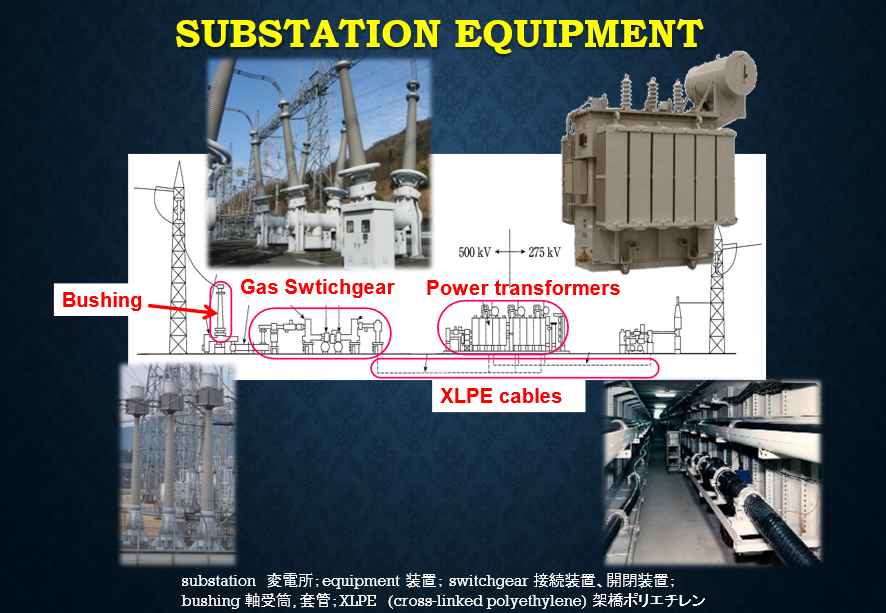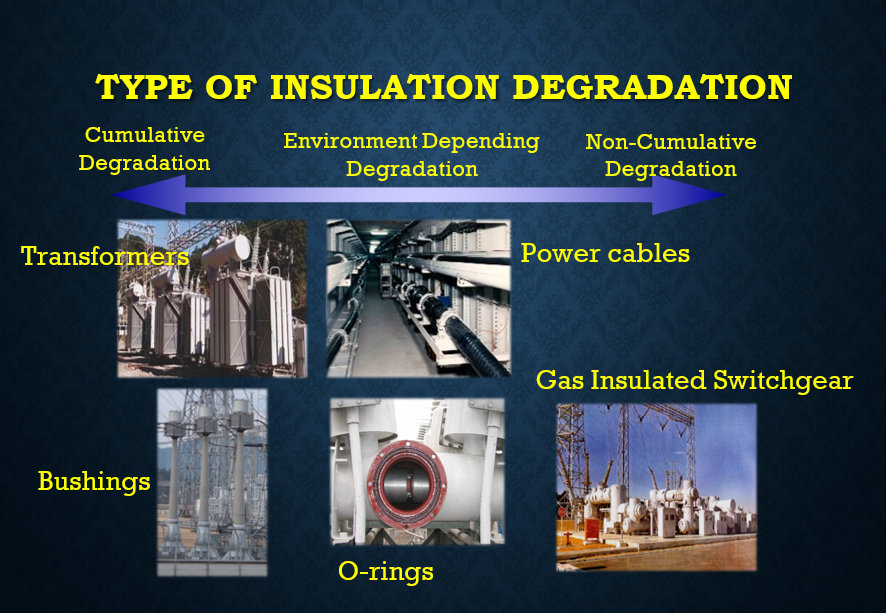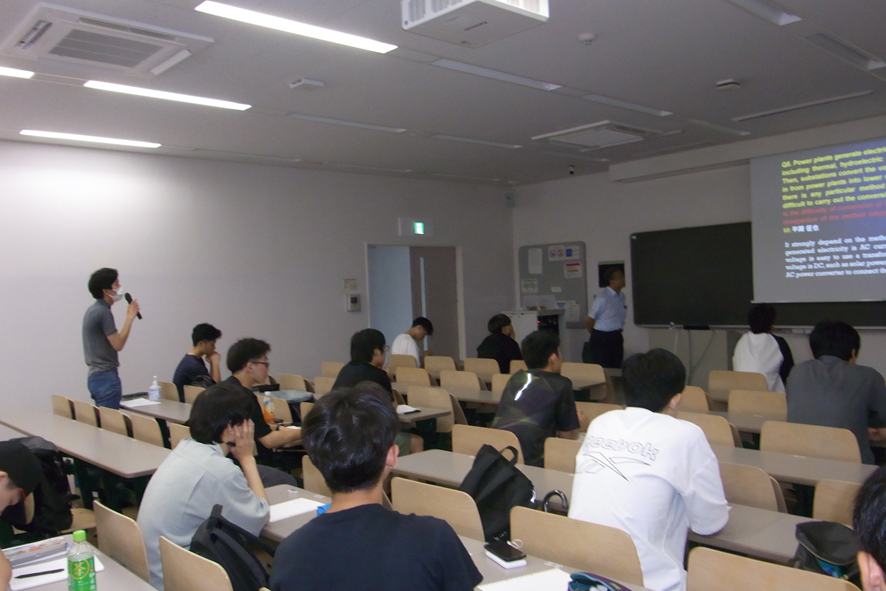[理工学部、建築・環境学部教養学会ミニ講演会] (第68回理科系学生のための公開英語講演会)
Methods for Diagnosing High Voltage Equipment
高電圧機器の診断手法
講師:財団法人電力中央研究所名誉研究アドバイザー
本学工学総合研究所研究員
岡本 達希 先生

On July 1st, 2024, the 68th session of the English Lecture Meeting for Science Major Students was held under the sponsorship of the Academic Society of Faculty of Liberal Arts, inviting Dr. Tatsuki Okamoto, a Research Adviser of Emeritus of Central Research Institute of Electric Power Industry (財団法人電力中央研究所名誉研究アドバイザー)as a lecturer.
It goes without saying that electricity is a vital source of energy for the present-day society. It is for this reason that we are concerned about how it is generated: the way the electricity is generated is directly related to the way the environment is affected. Note, however, that we tend to forget the fact that efficiency in transmission of electricity is also a vital matter when we consider the environmental issues; for in proportion to the loss of electricity in the course of its transmission, the corresponding amount of electricity needs to be generated additionally.
Dr. Okamoto is an expert on High Voltage Engineering who has been engaged in the research of Diagnosis of High Voltage Electric Appliances and Development of Computer-Aided Diagnosis Technology in the Central Research Institute of Electric Power Industry for more than 40 years. The main topic of this lecture was methods for diagnosing power equipment such as Power Transformers, Power Cables, Gas Insulated Switchgears, or other power equipment. Specifically, the lecturer introduced the latest technology for diagnosing the condition of those large power appliances, which sustain our civilized life. The audience, many of whom were students majoring in electricity, had a great opportunity to learn from Dr. Okamoto’s lecture based on his long experience as a person responsible for the transmission of electricity more about electric transmission such as: how the transmission of electricity is watched for its orderly function; by whom it is watched; what problems occur depending on the environment of each electrical substation; how much amount of electric energy is lost in the course of the electric transmission in Japan and in other countries, and so forth.

In the introductory portion of this lecture, Dr. Okamoto, by way of clarifying the reason why electric energy is important in modern society, referred to two notable characteristics of electric energy. First, electric energy can be converted into other types of energy quite efficiently; specifically, preserving almost 100% of its energy when converted into heat energy, 30~90% into light energy, and almost up to 95% into mechanical power. Furthermore, electric energy can be transported over a long distance at high voltage and without time delay, all of them being vital properties for maintaining the development of modern industry. Secondly, the lecturer explained what roles in the transmission lines substations and its equipment play such as “Bushings,” “Gas Switchgears,” “Power Transformers,” “XLPE Cables.” Third, the lecturer referred to the importance of the task of insulating equipment in transmission and its difficulty. Since each piece of equipment on the transmission line is made of different kinds of insulating materials, estimating the life of each equipment is difficult both physically and theoretically. The lecturer went on to show that the degradation of insulating materials can be categorized into three main types in terms of what its most prominent factor is: i.e. “cumulative degradation,” “environment-dependent degradation,” and “non-cumulative degradation.” It was reported that with there being no established manuals for restoring degraded equipment, the most appropriate method for restoration for each case of degradation must be figured out based on on-the-spot investigation.

After having explained in detail methods for diagnosing power equipment, the central topic of this lecture, Dr. Okamoto concluded by saying, “A large number of materials have been used in power equipment; similarly, a large number of methods for their employment have been developed. Also, numerable methods for diagnosing the degradation of power equipment have been proposed and adopted. In fact, there is no single optimal method available for diagnosing degradation in every case. What we have to do to cope with this reality is to try to find the best combination from among several diagnosing methods and set up a multi-layered diagnosing system depending on the situation in each case. In other words, we need to try our best to meet the requirements for finding a diagnosis method with higher and higher reliability.”
Dr. Okamoto finished this lecture with the following comments: “Though all of you may not be students majoring in “electricity,” it will be very useful for any type of engineer, irrespective of his or her specific task, to be familiar with basic properties of electricity. Naturally, electricity can be extremely dangerous depending on how we treat it; therefore, if you have good knowledge about, say, what would happen to the circuit at what voltage, it will certainly make an excellent engineer out of you in any company or institution.”

The following represents questions and answers in the subsequent Q and A session, where Dr. Okamoto gave detailed answers to all the questions raised by the audience:
Q. Prior to this lecture, I learned that power cables may be installed as permanent wiring within buildings, buried in the ground, run overhead, or exposed. Could you explain what the differences, advantages, or disadvantages are between underground and overhead installation of power cables. Also, if I may, I would also like to know what the criteria are for deciding on the most appropriate mode of installing power cables from among those various methods.
A. First of all, we should note that the cost for constructing an underground system of power cables is much higher, about ten times more expensive, than that for installing an overhead cable system; so, electric companies tend to avoid taking the underground option. However, in certain cases, for example when the cable lines must be installed in the middle of big cities, the underground option is difficult to avoid despite its high cost; in such cases, the government also insists the overhead cable system not be adopted. Among other major factors that are taken into consideration when installing power cable systems are safety of the system against natural disasters such as typhoons or earthquakes and city planning. While the underground cable systems can strongly resist earthquakes or typhoons, they take much longer time, more than ten years in some cases, to install than the overhead systems; after all, digging the ground in the middle of a city is quite a difficult, as well as time-consuming task, which often conflicts with city planning. In sum, utility companies must find the optimal solution for constructing a cable system after having fully considered several factors, which can vary according to individual situations.







